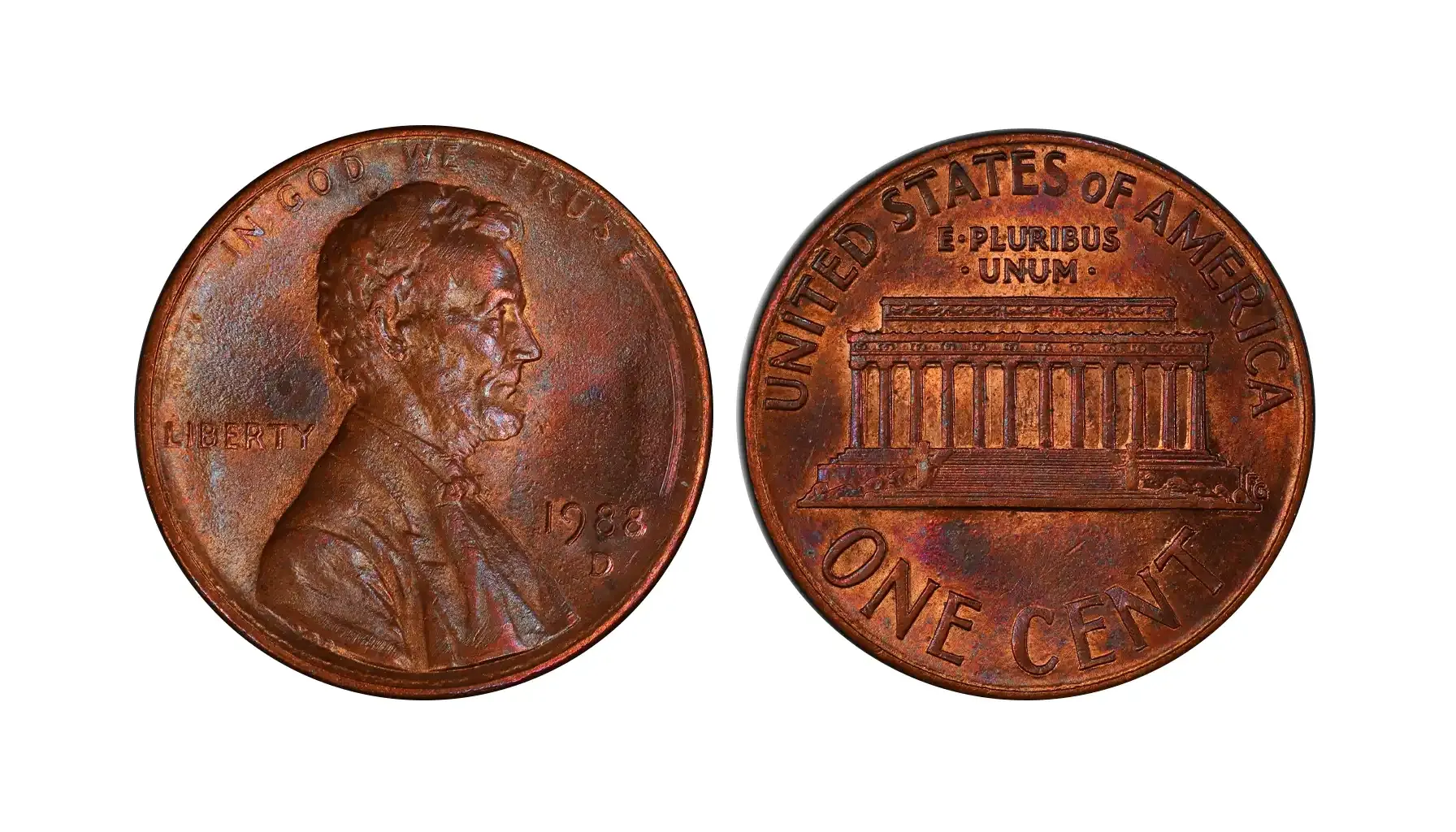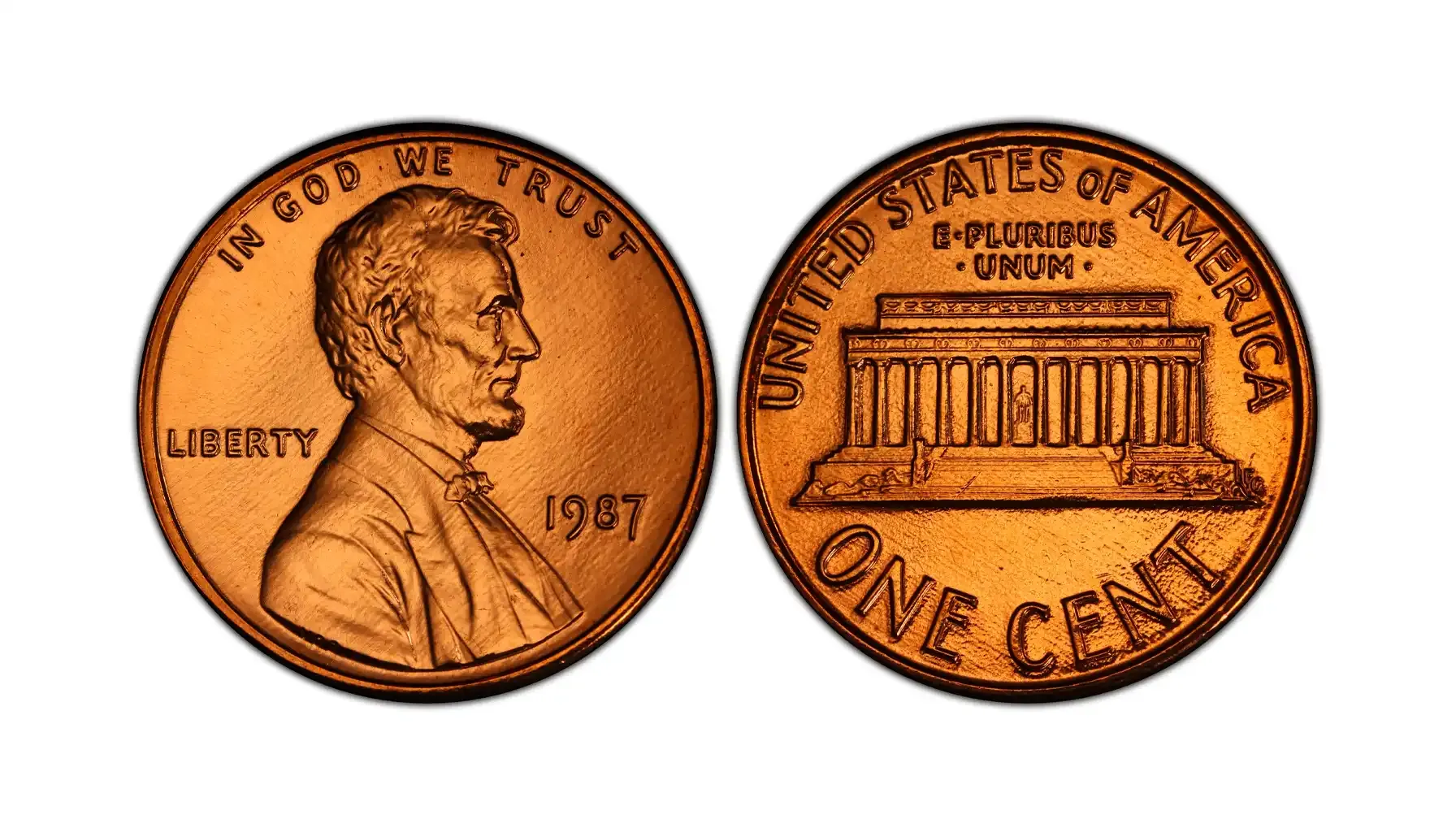Contents:
The power of coins is always underestimated: these small metal plates may bring their owners back in time, revealing the history of nations, the evolution of coinage, and even personal stories of those fortunate enough to keep them in their collections. But it is not about value or cultural significance – collecting should bring genuine joy, and this should not be confined to its commercial worth only.
The 1984 copper dime is a decent representative of the series, which cannot boast formidable prices but has long been regarded as an accessible and rewarding entry point for those who do not know where to start. In this material, we are to explore the main features that identify this coin as a noteworthy, if modest, piece, check its value, and define which options are worth collecting.
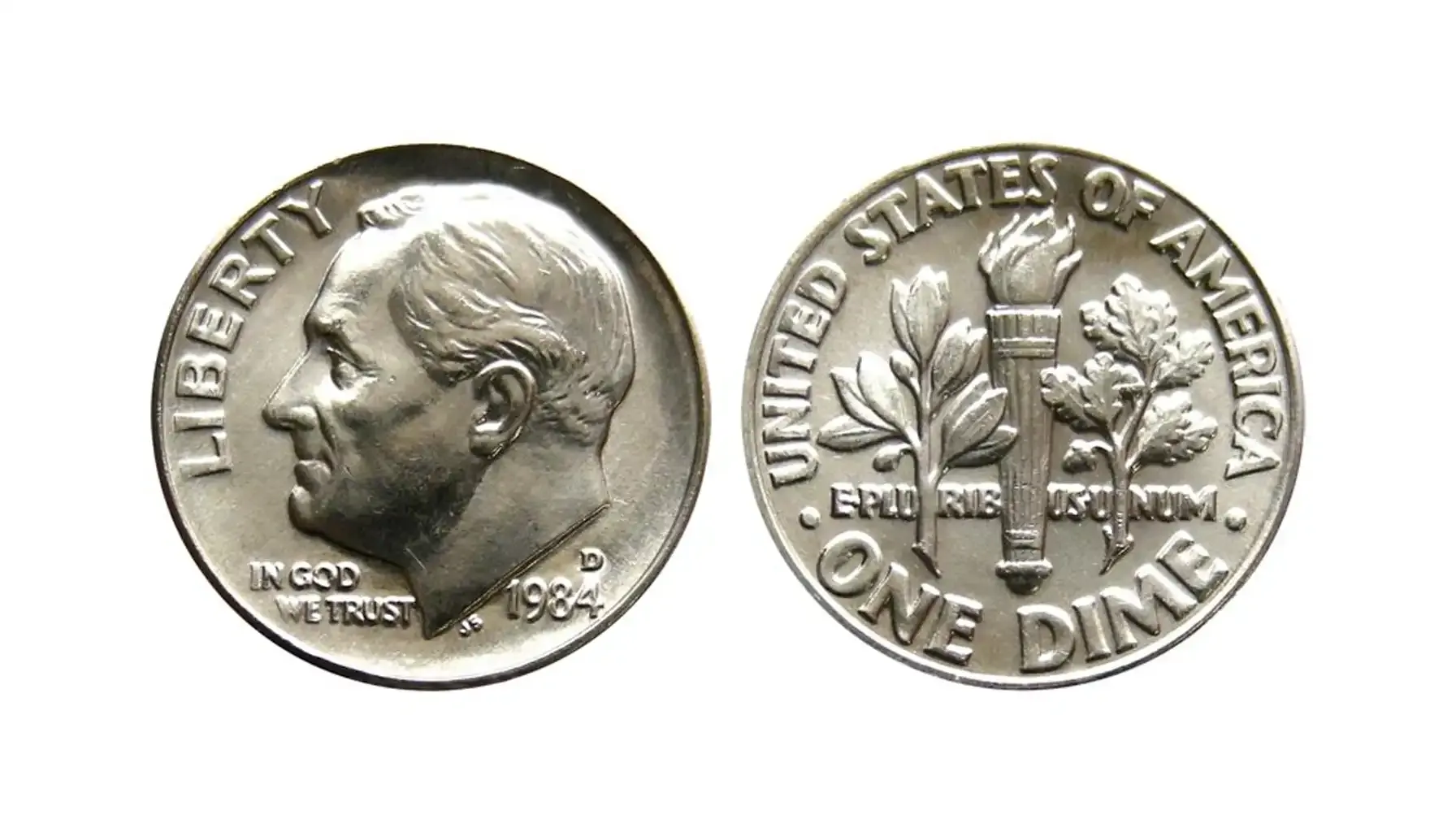
Roosevelt Dimes and Their History
The Roosevelt dimes have a long, captivating history that has not come to its end yet. Having been introduced with the 1946 dime, the coin further became a living but controversial numismatic legend that had been launched after the death of President Franklin D. Roosevelt for commemorative purposes. This initiative was not brought on a whim – it was a carefully considered tribute to a fallen leader who fought against polio through the March of Dimes* campaign.
The contributions of the 32nd president could not be perpetuated in simple words – this would not be enough for sure. To honor achievements made during Roosevelt's presidential term, the US Mint decided that they replace the aging and already outdated Mercury 10-cent coin with a new, fresh design bearing his profile.
Originally produced in 90% silver and 10% copper, it could not escape the fate of other coins and also underwent a few compositional changes, e.g., the Coinage Act of 1965 presupposed that all dimes (starting with the 1965 dime), quarter dollar, and half dollar either reduce their silver content significantly or eliminate it for good. This was the moment when dimes turned to their current composition of cupronickel alloy.

*The March of Dimes is a nonprofit organization founded by President Franklin D. Roosevelt in 1938 to combat polio and further aim at the improvement of the health of mothers and their newborns. This was the central power in funding the development of the polio vaccine and remains one of the main channels of support for research and advocacy in prenatal health in the US.
Design and Physical Characteristics of the One Dime 1984
Obverse: The obverse features a left-facing portrait of President Franklin D. Roosevelt, designed by John R. Sinnock, along with the inscriptions “LIBERTY” to the left of profile, “IN GOD WE TRUST” below the chin, the year “1984” to the lower right, a mint mark above the date, and the initials of the designer “JS” to the left of the date.
Reverse: The reverse demonstrates three main elements, i.e., a torch in the center, an olive branch to the left of the torch, and an oak branch to the right. As for the inscriptions, they include “UNITED STATES OF AMERICA” along the upper rim, the motto “E PLURIBUS UNUM” centered beneath the torch, and “ONE DIME” along the bottom edge.
The Main Features of the 1984 Dimes | |
Composition | Outer layers of 75% copper, 25% nickel Core of pure copper |
Diameter | 17.91 mm |
Thickness | 1.35 mm |
Weight | 2.27 grams |
Edge | Reeded (118 reeds) |
Mint Marks | “P” for Philadelphia “D” for Denver “S” for San Francisco |
Years of Issue | 1946–present |
Material Type | Clad (copper-nickel over copper core) |
Mintages and Varieties by Mint
1984 P Dime (Regular Strike)
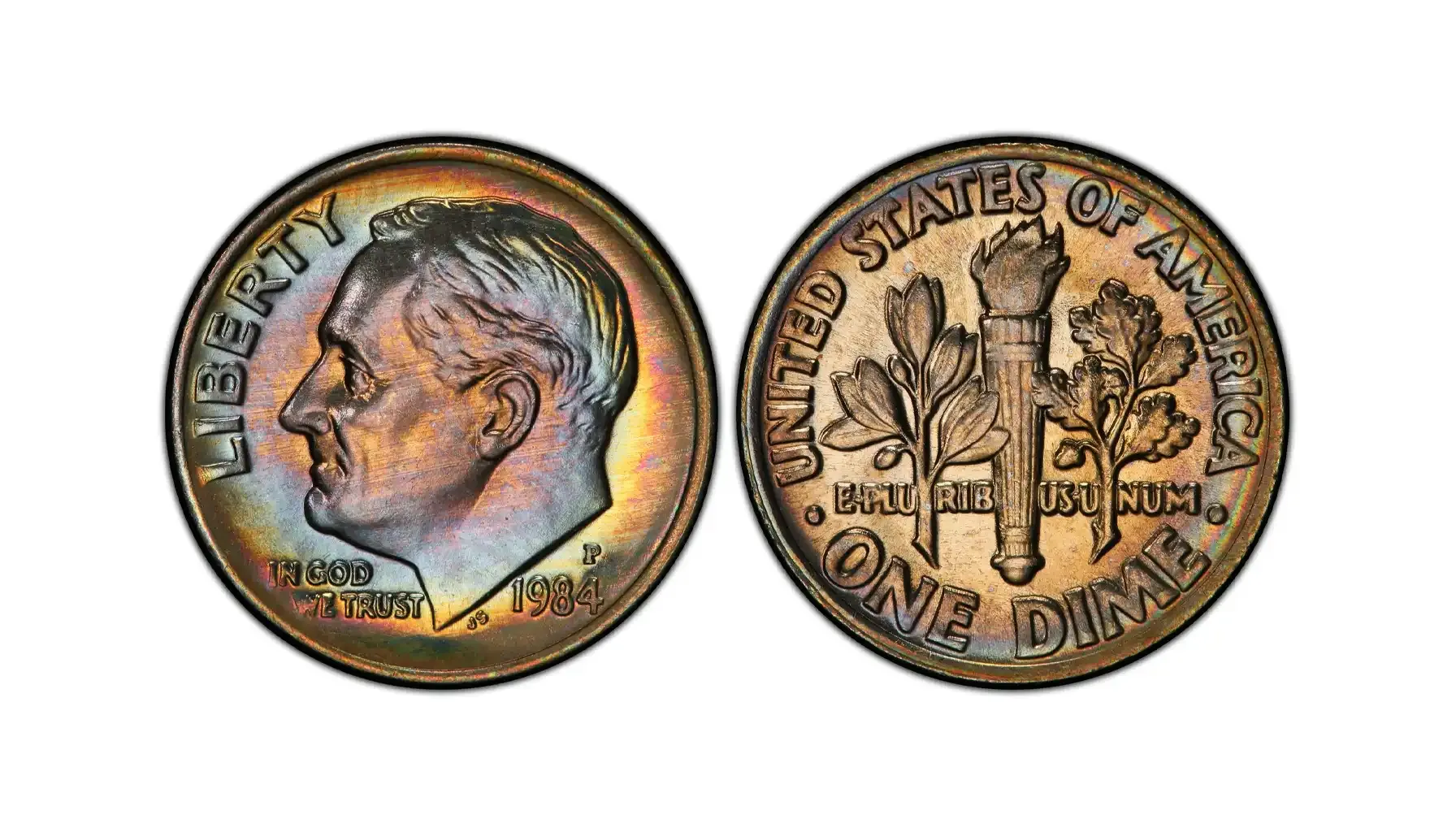
Produced by: Philadelphia Mint
Mintage: 856,669,000
Designations: MS, FB (Full Band)
Auction Record: $855 for MS68FB
The 1984 P Roosevelt Dime, which came from the Philadelphia Mint, is a widely available and frequently found instance in circulation. It is obvious that the lower Mint State examples are abundant, yet high-grade Full Band specimens are considerably scarcer and more valuable, especially when these are MS68 or higher.
1984 D Dime (Regular Strike)
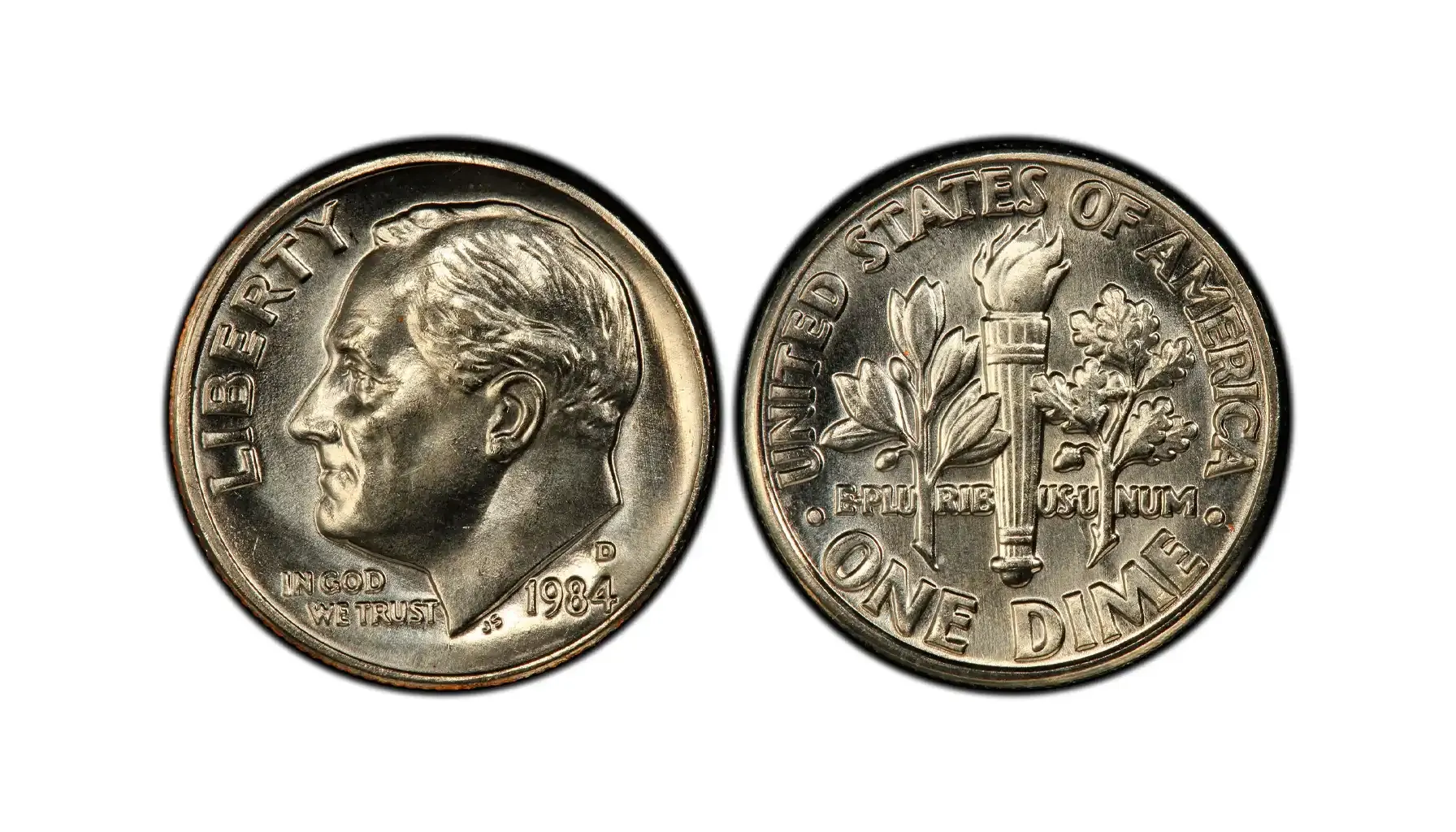
Produced by: Denver Mint
Mintage: 704,803,976
Designations: MS, FB (Full Band)
Auction Record: $1,323 for MS60
Another major facility located in Denver released its own iteration, which can be considered extremely common in grades up to MS64 and can still be found in pocket change. According to Jaime Hernandez, the expert from PCGS, MS66 Full Bands examples may occasionally turn up in rolls or mint sets, but MS68 coins are nearly unattainable, with very few certified and none finer.
1984 S Dime (Proof, DCAM)

Produced by: San Francisco Mint
Mintage: 3,065,110
Designations: PR, DCAM (Deep Cameo)
Auction Record: $920 for PR70
When coins are exclusively struck for collectors, these are called "proofs". As for the 1984 issue, proof instances feature deep mirror fields and frosted devices with common designations like PR and DCAM (which refer to the level of precision and quality of production). In fact, these have never been intended for circulation; instead, they can only be found in proof sets or on the most reputable coin auction platforms in separate slabs.
The 1984 Dime Error List with Pictures
Doubling Eye
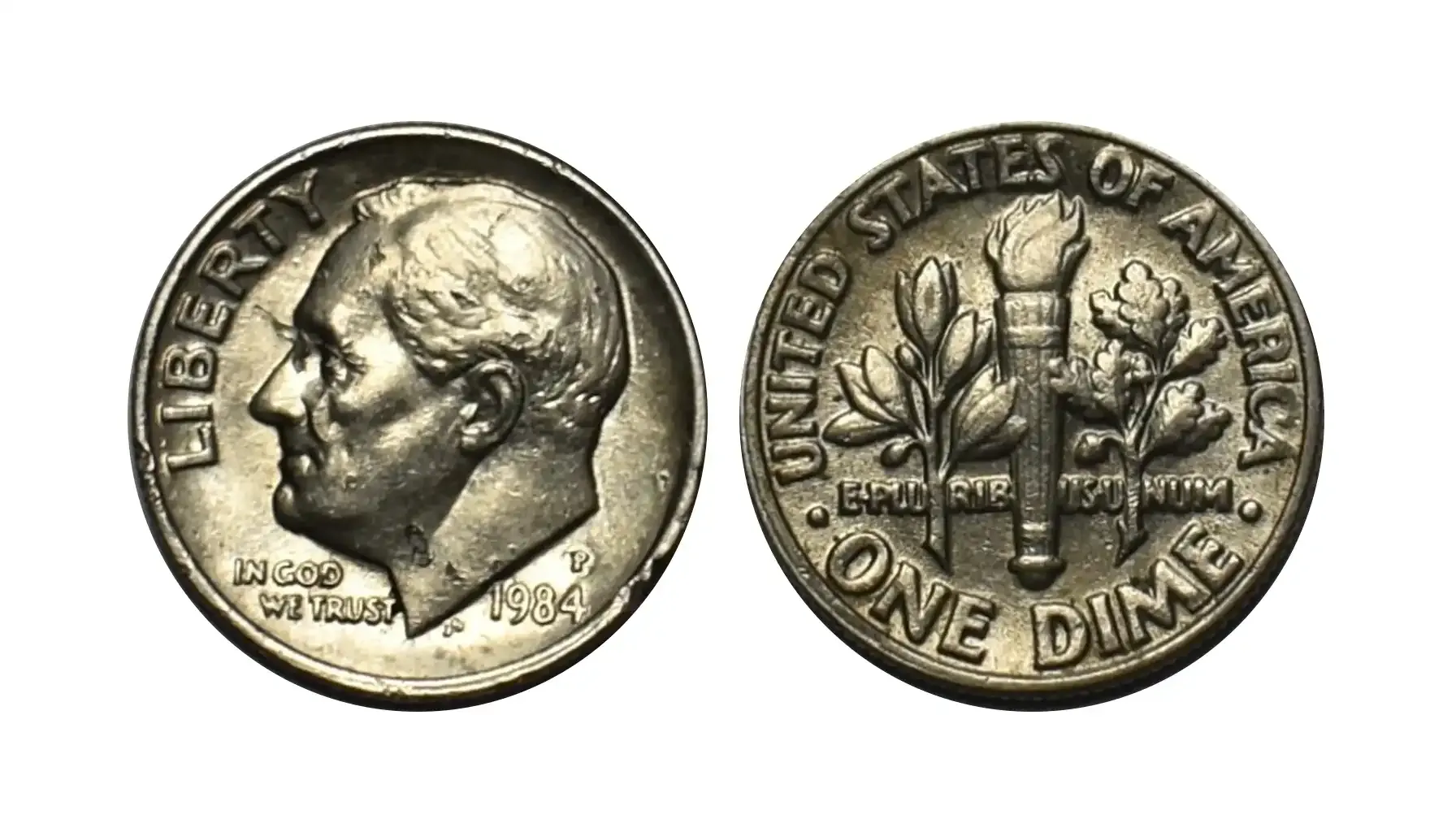
Estimated Value: $355
Doubled die 1984 dime errors may vary, and this comes down to the subject of doubling in particular. When these deviations affect Roosevelt’s eye, it produces a ghost-like or shadowed appearance, which refers to one of the most sought-after errors of this iteration.
Die Clash

Estimated Value: $341
One more popular error is a die clash that occurs when the obverse and reverse dies strike each other without a planchet between them. As a result, there appear to be impressions of one side on the other.
Date Filled In
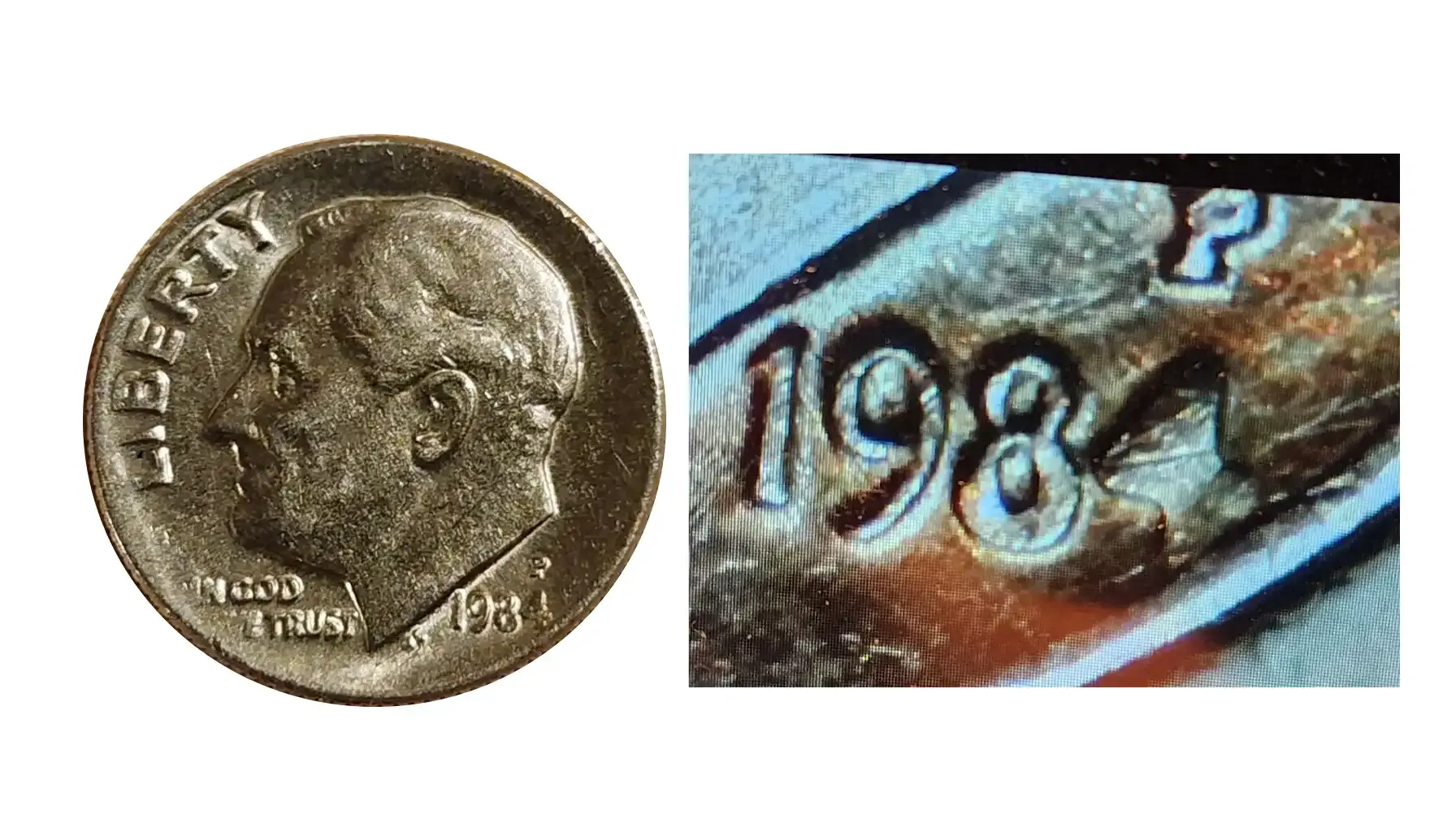
Estimated Value: $299
Filled-in errors are as diverse as doubling, too. As such, this flaw is produced when grease partially fills the date during striking, causing digits (often the “9” or “4”) to appear deformed. Although it is a minor deviation that may be considered the result of wear or optical illusion, it is a fairly decent example worth collecting.
Missing Obverse Clad Layer
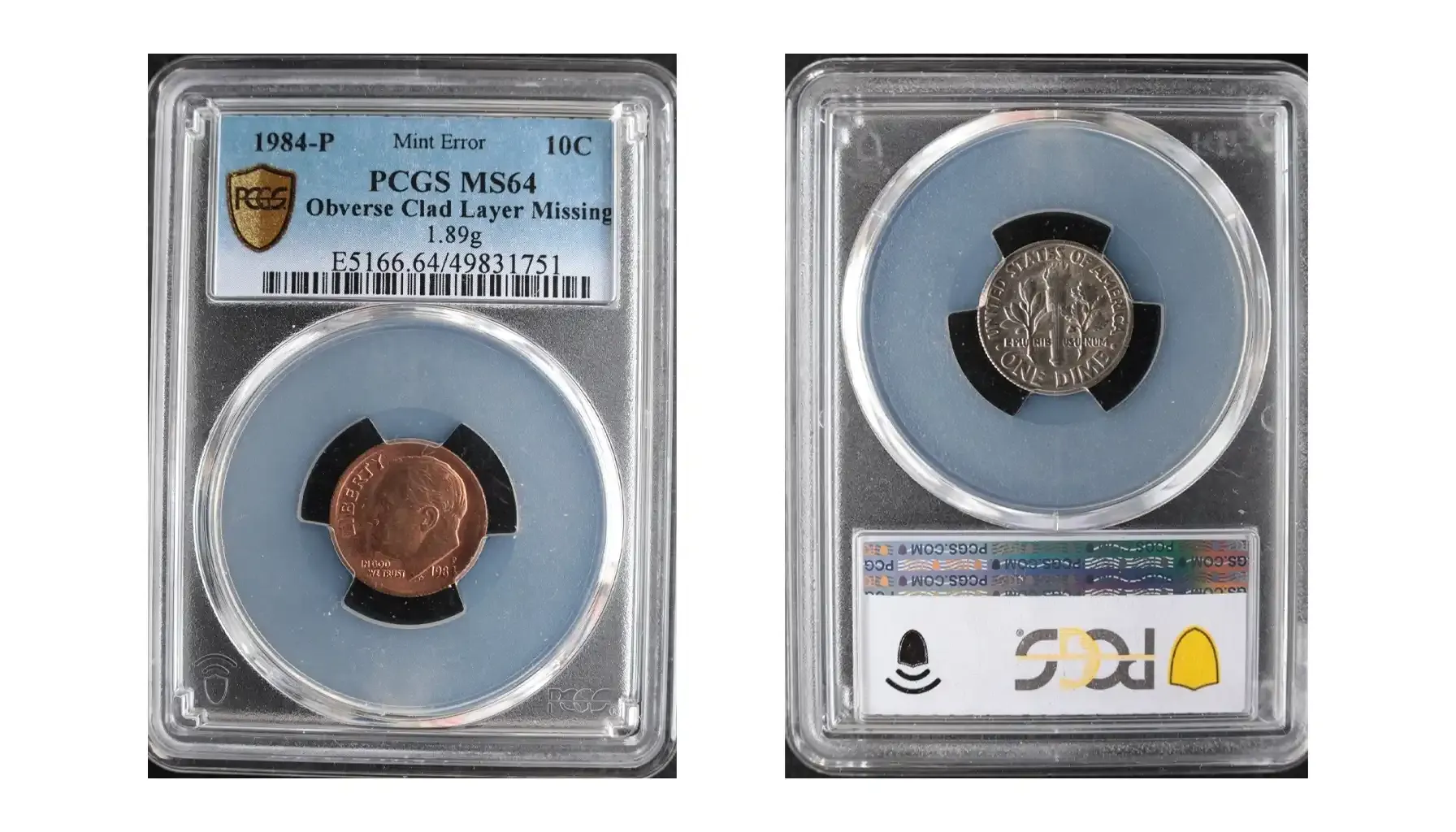
Estimated Value: $299
Some 1984 P dime errors, nevertheless, are not so obvious to pay attention to. For example, when the outer nickel layer fails to bond properly, part or all of the obverse shows exposed copper core. This turns a regular design into a dramatic two-tone structure, which captivates modern error collectors anyway.
Broadstruck Error
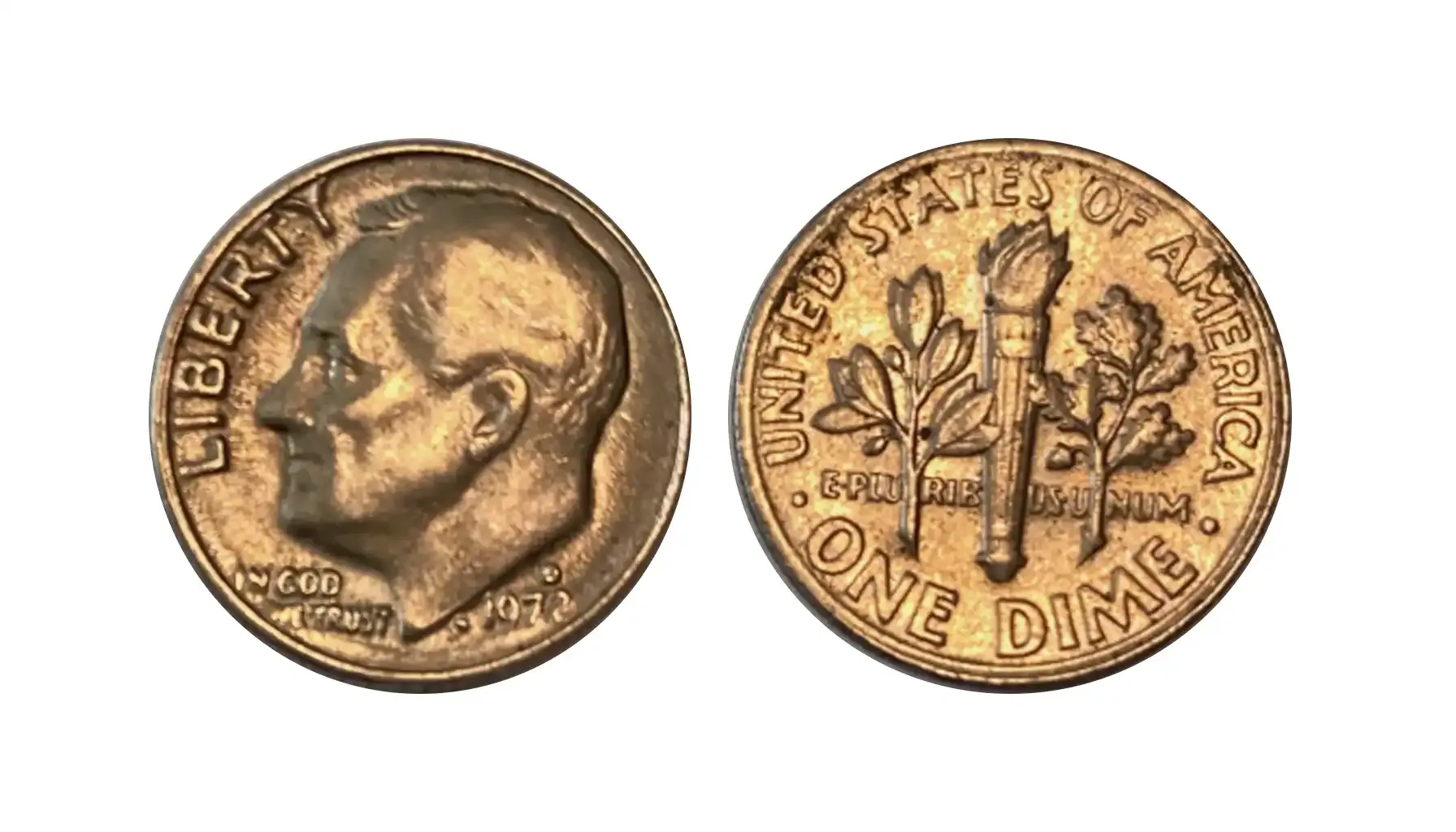
Estimated Value: $195
In this error, the coin is struck outside the retaining collar, which means that it spreads out wider than it should, lacking a defined rim in the end. How to identify this? Well, the answer is simple – should the coin look oversized, it is definitely a broadstruck flaw.
"In Cod We Trust" Error
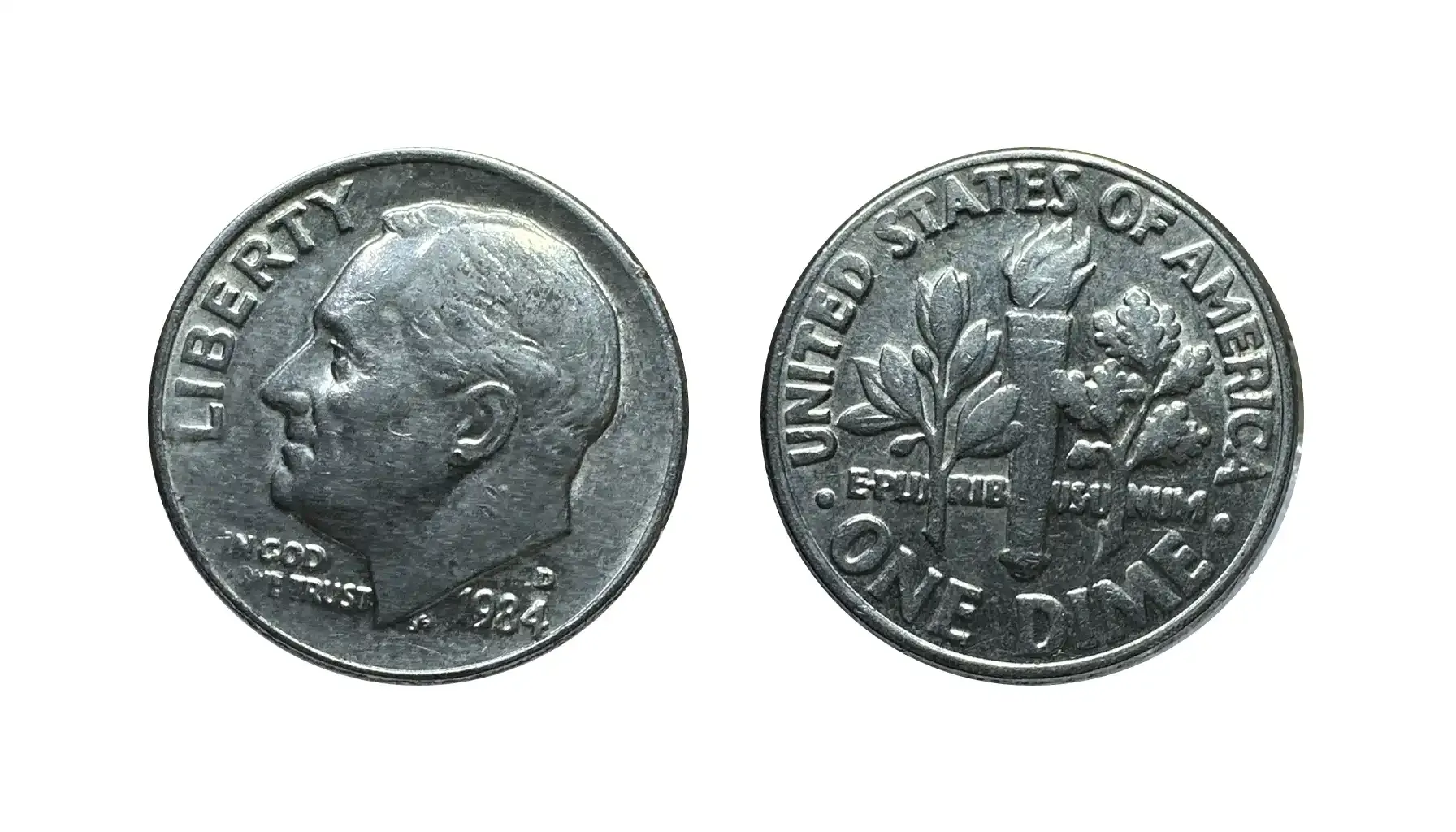
Estimated Value: $10
Finally, one may take a look at a popular yet not overly expensive error that is widely known by the public. In fact, a light strike or grease-filled die can deform the “G” in “GOD”, which is why there appears a peculiar pun “COD” instead of the intended word.
Related article: In Cod We Trust Quarters: 2022–2023 Values Explained
How Much Is a 1984 Dime Worth?
The 1984 copper dime value is a complex variable influenced by factors such as condition, rarity, and market trends. And while auction records can be impressive and even flabbergasting, they often reflect outliers rather than average results. This means that they are not always illustrative of what most collectors can expect. To truly understand the 1984 P dime value (as well as that of other iterations), it is important to consider the general pricing ranges across different grades.
By the way, identifying a genuine 1984 one dime coin value per grade is one of the most efficient ways to capture a more realistic picture of what the average collector might pay or receive. So, below is the table of the prices per coin, provided by the PCGS and NGC grading services.
Coin Variety | G4 (Good) | VF20 (Very Fine) | EF40 (Extremely Fine) | MS60 | MS65 | MS67+ |
1984-P 10C | $0.10 | $0.15 | $0.20 | $0.30 | $2 | $18–$855 (FB) |
1984-D 10C | $0.10 | $0.15 | $0.20 | $0.30 | $2 | $25–$1,323 (FB) |
1984-S 10C | – | – | – | – | $3 | $10–$920 (PR70) |
*Prices are subject to fluctuations. To learn more about relevant pricing, one is free to consult external resources like Coin iD Scanner. Coin ID Scanner is a comprehensive, all-in-one application that helps users identify coins, detect possible errors, check their current market value, manage collections, and interact with a community. Useful for those who need support but do not know where to turn to.
Dimes are not just 10-cent coins. These are vaults of power, history, and wealth, which may arise at any time. Do not neglect any sample – this can be the next relic to make you rich.


